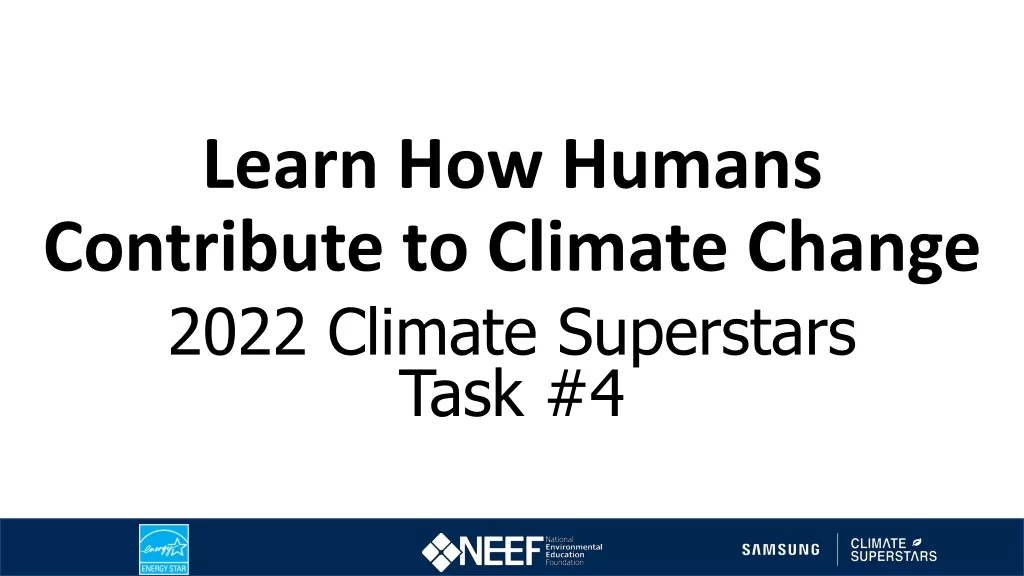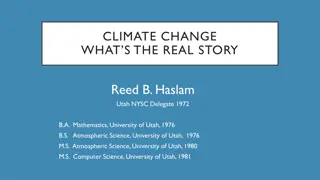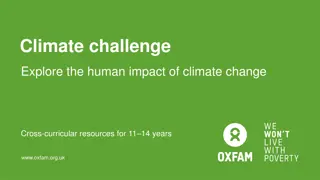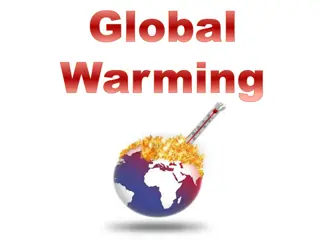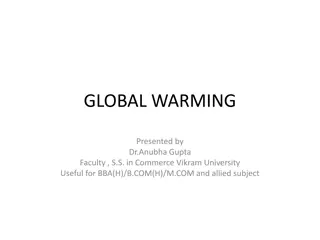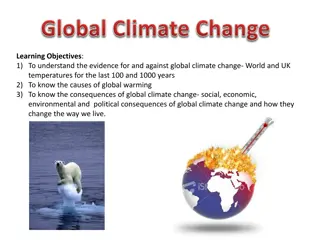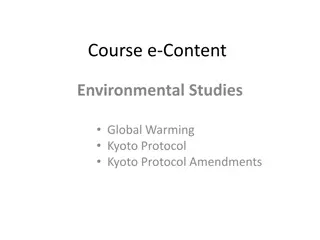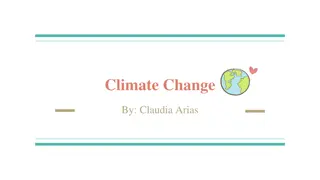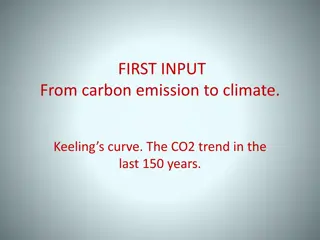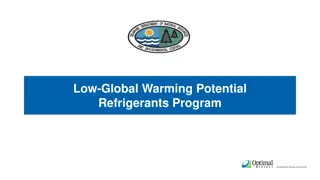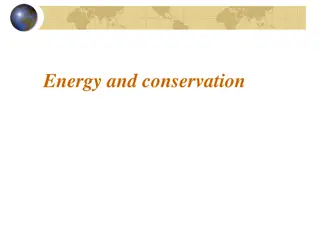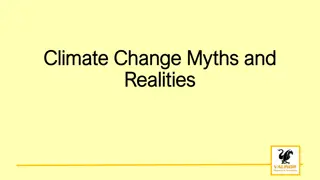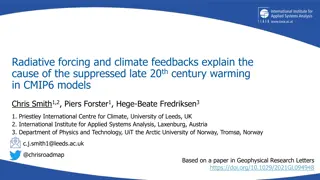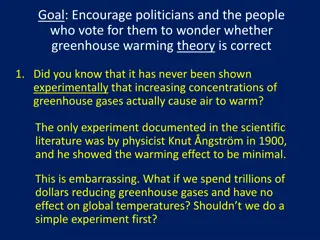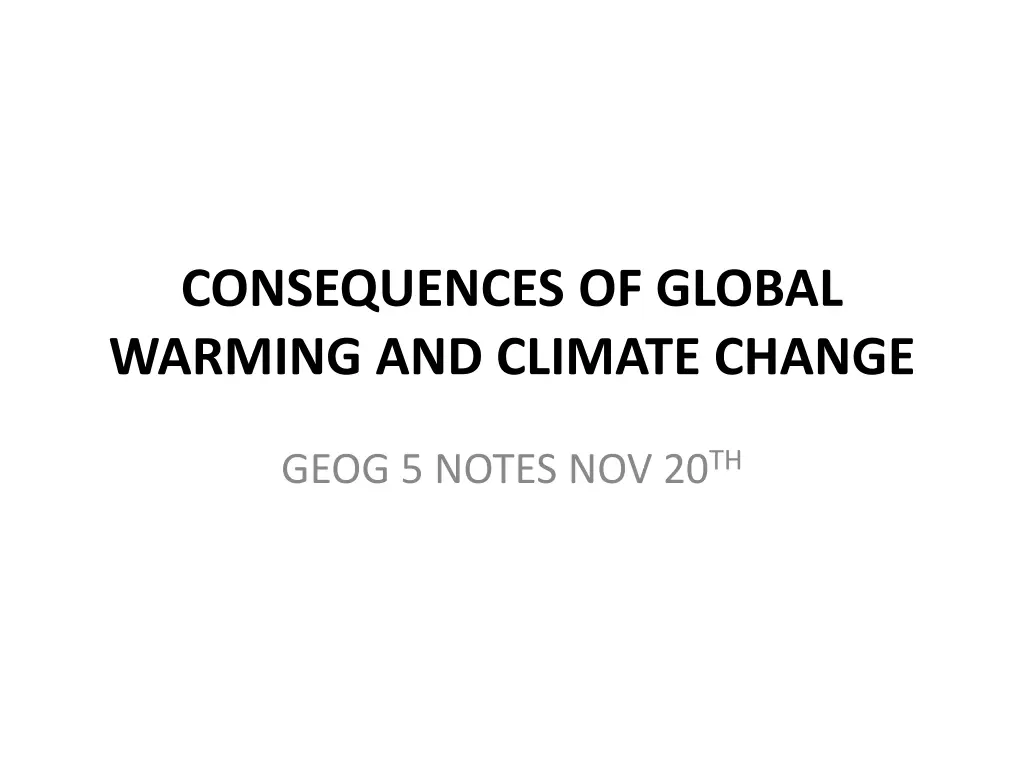
Impact of Global Warming and Climate Change on Environment and Cities
Explore the consequences of global warming and climate change, including rising sea levels affecting coastal cities like Miami, New York, and Washington. Witness the shrinking glaciers and increasing extreme weather events due to climate change. Understand the economic and social challenges posed by rising sea levels and the need for sustainable development to mitigate these effects.
Download Presentation

Please find below an Image/Link to download the presentation.
The content on the website is provided AS IS for your information and personal use only. It may not be sold, licensed, or shared on other websites without obtaining consent from the author. If you encounter any issues during the download, it is possible that the publisher has removed the file from their server.
You are allowed to download the files provided on this website for personal or commercial use, subject to the condition that they are used lawfully. All files are the property of their respective owners.
The content on the website is provided AS IS for your information and personal use only. It may not be sold, licensed, or shared on other websites without obtaining consent from the author.
E N D
Presentation Transcript
CONSEQUENCES OF GLOBAL WARMING AND CLIMATE CHANGE GEOG 5 NOTES NOV 20TH
Its getting warmer ... Whatever the cause of GW, all are agreed that it is taking place Global pattern of climate changing (see map fig7.31 p.200) Areas are likely to have wetter or drier weather (see map)
RISING SEA LEVELS Higher temps have shrunk major glaciers Arctic and Greenland Ice shrinking Antarctica peninsula ice sheet breaking up All these stores of ice are unlocked and melting In Greenland the edges of the ice sheet are melting but the core is becoming colder why? (see map fig 7.32 p.200) Global SL risen by 20 cm since 1880 Most predictions about future SL range between 1-2m by 2100 Threat greatest at coastal cities eg Miami which would suffer from 1m rise due to high prop values and downtown would be disconnected Other US cities with probs would be: NY, New Orleans, Boston, Washington, Phil, Tampa and San Francisco. Int l cities that would also suffer: Osaka, Kobe, Tokyo, Rotterdam, Amsterdam, Nagoya.
RISING SEA LEVELS Continued dev t of low areas should stop. Other probs: Where would evacuees be resettled? The economic activity? Rising SL will cause major economic and social, migrational upheaval.
MORE HAZARDS Increases in extreme weather: tropical storms, tornadoes, heatwaves, droughts and cold snaps Warmer seas = more intense storms (eg Sandy) Increased rainfall events in Northern Hemisphere increased since 1980 (more flooding) Increasing El Ni o events (see FB video on El Ni o and ocean currents) Frequent, longer lasting droughts are causing desertification. Sahel expanding rapidly More heatwaves, more frequently eg France 13,000 died in 2003
ECOSYSTEM CHANGES Distribution changes more moving northwards. Coniferous biome moves into Tundra and that into ice desert (fig 7.36 p 203)
ECONOMIC OPPORTUNITIES Agriculture new exposed land and in higher latitudes New shipping lanes Wetter climate beneficial in some areas But also increased aridity and less productive land will balance this out Resources will get uncovered and exploited (esp North Pole)
HEALTH Distributions of diseases will change Malaria at higher latitudes Scarcer water will lead to dirty water consumed in many areas so spread of cholera, typhoid, bilharzias. Mortality rates expected to rise
CONFLICT Increased food and water insecurity can lead to conflict Forced migrations
CASE STUDY: TUVALU AND BANGLADESH ARE DROWNING Polynesian state reef and coral islands between Hawaii and Australia. Only 26 km2 12,500 popn. 4thsmallest country in the world. Highest point = 4.5m asl May be first to disappear become a ghost state Where will they resettle? Will it still exist as a state though underwater?
CASE STUDY: TUVALU AND BANGLADESH ARE DROWNING Bangladesh has 154m people, pop density of 1045 ppkm2 Low lying and vulnerable Megadelta floodplain of 3 rivers Ganges, Brahmaputra and Meghna. 75% of country under 10m asl (see map p.205) 1m rise would affext 40m people where could they go? Bangladesh is a multiple hazard zone and these will get worse too. As will health and well-being.
SO, WHAT CAN WE DO? If we don t believe it is man-made then we can t do anything just adapt. If we do believe in greenhouse gases, then we could: Cut down on FFs and CO2 emissions and atmospheric pollution Use alternative energies Reduce rate of deforestation and encourage afforestation More carbon capture Need China and USA to move in right direction (see carbon emissions chart p. 206) TOP 10 CULPRITS: USA CHINA RUSSIA JAPAN INDIA GERMANY UK CANADA ITALY MEXICO USA is skeptical, China refuses to slow down industrialization, but may change mind due to Tibetan Glacier melt affecting Yantze river. Russia s forests = significant carbon sink China, India, Mexico and other LICs more concerned with poverty HICs like Japan, and EU countries shown willing to cut emissions.
CASE STUDY: CHALLENGE OF INTERNATIONAL COOPERATION OVER CARBON EMISSIONS Montreal Protocol 1987 CFCs damage to ozone layer which protests us from UV Earth Summit 1992 Rio De Janeiro future use of resources and protection of env. Kyoto 1997 treaty to implement UNFCC recommendations (cut GHs by 5% by 2012 based on 1990 figures). Had to be signed by 55 countries to be ratified. Only 38 signed. Sweden has reduced emissions by 10% USA, China and India have not signed and they account for 50% of the emissions. Kyoto also set up CLEAN DEVELOPMENT MECHANISM (CDM) where carbon credits can be bought and sold. (see case study notes for details) Copenhagen 2009 hoping for more emission cuts but no real results or targets. LICs would not cooperate HICs may need to support LIC low-carbon projects
ALTERNATIVE ENERGY SOURCES Initial capital investment high and energy output is low. Nuclear power brings up concerns of safety and security Make homes energy-efficient Road transport alternatives becoming available but what about air travel? Maybe biofuel can replace petrol for air and sea travel?
ADAPTING TO GW AND CLIMATE CHANGE Adapt where and how we live Rising SLs: invest in coastal defences or retreat from vulnerable areas. Plan for relocation of people and economic activity More hazards: improve prediction and invest in preparation and investment. Ecosystem changes and economic opportunities: abandon areas difficult to cultivate. Invest in new areas and increase search for resources in new areas. Health and well-being: improve medical treatment of new diseases Conflict: defuse conflict via cooperation and fairer distribution of food and water.

